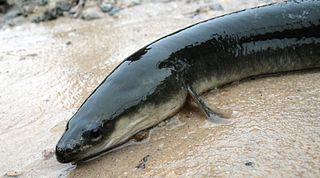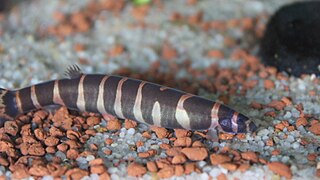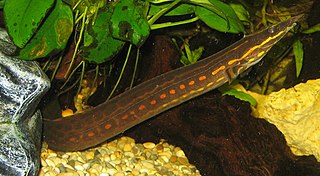Kryptopterus bicirrhis, often called the glass catfish, is an Asian glass catfish species of the genus Kryptopterus. Until 1989, the concept of K. bicirrhis included its smaller relative Kryptopterus vitreolus. Its scientific name K. bicirrhis and common name glass catfish are often still used in the aquarium fish trade to refer to the actual K. vitreolus; as it seems, the larger and more aggressive true K. bicirrhis was only ever exported in insignificant numbers.

The American eel is a facultative catadromous fish found on the eastern coast of North America. Freshwater eels are fish belonging to the elopomorph superorder, a group of phylogenetically ancient teleosts. The American eel has a slender, snake-like body that is covered with a mucus layer, which makes the eel appear to be naked and slimy despite the presence of minute scales. A long dorsal fin runs from the middle of the back and is continuous with a similar ventral fin. Pelvic fins are absent, and relatively small pectoral fins can be found near the midline, followed by the head and gill covers. Variations exist in coloration, from olive green, brown shading to greenish-yellow and light gray or white on the belly. Eels from clear water are often lighter than those from dark, tannic acid streams.
The Notacanthiformes are an order of deep-sea ray-finned fishes, consisting of the families Halosauridae and Notacanthidae.

Sand eel or sandeel is the common name used for a considerable number of species of fish. While they are not true eels, they are eel-like in their appearance and can grow up to 30 centimetres (12 in) in length. Many species are found off the western coasts of Europe from Spain to Scotland, and in the Mediterranean and Baltic seas.

Pangio is a genus of small Asian freshwater fish in the true loach family Cobitidae. In earlier taxonomic schemes it was known as Acanthophthalmus. The "kuhli loach" is well-known in the aquarium trade and commonly identified as P. kuhlii, but most individuals actually appear to be P. semicincta.

The walking catfish is a species of freshwater airbreathing catfish native to Southeast Asia. It is named for its ability to "walk" and wiggle across dry land, to find food or suitable environments. While truly, it does not walk as most bipeds or quadrupeds do, it has the ability to use its pectoral fins to keep it upright as it makes a wiggling motion with snakelike movements to traverse land. This fish normally lives in slow-moving and often stagnant waters in ponds, swamps, streams, and rivers, as well as in flooded rice paddies, or temporary pools that may dry up. When this happens, its "walking" skill allows the fish to move to other aquatic environments. Considerable taxonomic confusion surrounds this species and it has frequently been confused with other close relatives. One main distinction between the walking catfish and the native North American ictalurid catfish with which it sometimes is confused, is that the walking catfish lacks an adipose fin.

Lake Võrtsjärv is a lake in southern Estonia with an area of 270 km² (104 mi²).

The Thamirabarani or Tamraparni or Porunai is a perennial river that originates from the Agastyarkoodam peak of Pothigai hills of the Western Ghats, above Papanasam in the Ambasamudram taluk. It flows through Tirunelveli and Thoothukudi districts of the Tamil Nadu state of southern India into the Gulf of Mannar. It was called the Tamraparni River in the pre-classical period, a name it lent to the island of Sri Lanka. The old Tamil name of the river is Porunai. From the source to sea, the river is about 128 kilometres (80 mi) long and is the only perennial river in Tamil Nadu. This river flows towards north direction initially. However, it changes to east direction later.

Amphibious fish are fish that are able to leave water for extended periods of time. About 11 distantly related genera of fish are considered amphibious. This suggests that many fish genera independently evolved amphibious traits, a process known as convergent evolution. These fish use a range of terrestrial locomotory modes, such as lateral undulation, tripod-like walking, and jumping. Many of these locomotory modes incorporate multiple combinations of pectoral, pelvic and tail fin movement.

The lesser fish eagle is a species of Haliaeetus found in the Indian subcontinent, primarily in the foothills of the Himalayas, and south-east Asia. There are records from Gujarat, Central India and in more recent times from the Kaveri river valley in southern India. Some taxonomic authorities place this species in the monotypic genus Ichthyophaga. Others place it in the genus Haliaeetus.

The fire eel is a relatively large species of spiny eel. This omnivorous freshwater fish is native to in Southeast Asia but also found in the aquarium trade. Although it has declined locally because of this trade and overfishing for food, it remains common overall.
The wildlife of Mauritius is composed of its flora and fauna. Mauritius is located in the Indian Ocean to the east of Madagascar. Due to its isolation, it has a relatively low diversity of wildlife; however, a high proportion of these are endemic species occurring nowhere else in the world. Many of these are now threatened with extinction because of human activities including habitat destruction and the introduction of non-native species. Some have already become extinct, most famously the dodo which disappeared in the 17th century.

The Java loach is a species of tropical freshwater fish, an unbanded kuhli loach, native to the sandy streams of Southeast Asia. Its alternative common names include the black kuhli (loach), chocolate kuhli and cinnamon loach. It is common in the aquarium trade.

Pangio semicincta is a species of cobitid loach in the genus Pangio found in the Malay Peninsula, Borneo, and Sumatra. It is a very popular fish in the aquarium trade, however it is often confused for and mislabeled as Pangio kuhlii, which is rarely if ever found in the aquarium trade due to it being endemic to the island of Java, where collection for the fish trade is rare.
The Borneo loach is an Southeast Asian species of cobitid fish. It is a river fish found on the Malay Peninsula, Sumatra and Borneo

Peronedys anguillaris, the eel blenny, is a species of clinid found in estuaries of southern Australia where it only inhabits beds of eelgrasses where the living grasses are bedded in decaying grasses. It can reach a maximum length of 13 centimetres (5.1 in) TL.
Blennophis anguillaris, the snaky klipfish, is a species of clinid found in the subtropical waters of the Atlantic Ocean around South Africa. It can be found in the subtidal zone and also is a denizen of tidepools. This species can reach a maximum length of 30 centimetres (12 in) TL.
The kuhli loach is a small eel-like freshwater fish belonging to the loach family (Cobitidae). They originate from Indonesia and the Malay Peninsula. This snake-like creature is very slender and nocturnal. In an aquarium, the kuhli loach can be very reclusive and, when startled, will dart underneath tank ornaments or bury itself, if a fine gravel or sandy substrate is present.

Loaches are fish of the superfamily Cobitoidea. They are freshwater, benthic (bottom-dwelling) fish found in rivers and creeks throughout Eurasia and northern Africa. Loaches are among the most diverse groups of fish; the 1249 known species of Cobitoidea comprise about 107 genera divided among 9 families.












